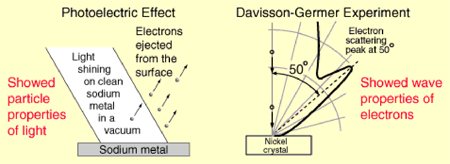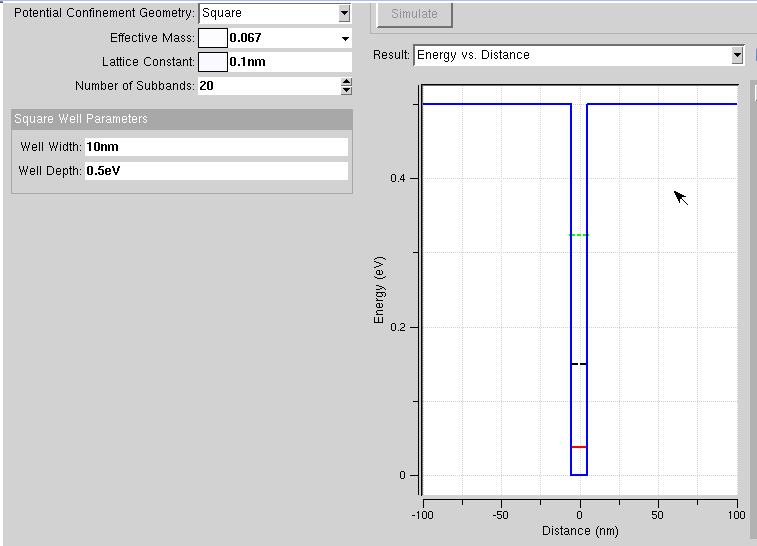AQME
Introduction to Quantum Mechanics for Physicists and Engineers with AQME Nanotechnology has yielded a number of unique structures that are not found anywhere in nature. Most demonstrate an essential quality of Quantum Mechanics known as quantum confinement. The idea behind confinement is all about keeping electrons trapped in a small area. The sizes we’re talking about here for confinement have to be less than 30 nm for effective confinement. Quantum confinement comes in several flavors. 2-D confinement is only restricted in one dimension, and the result is a quantum well (or plane). These are what most lasers are currently built from. 1-D confinement occurs in nanowires. 0-D confinement is found only in the quantum dot.
One is probably wondering why confinement is so important. For one thing, it leads to new electronic properties that are not present in today’s semiconductor devices. Consider the quantum dot. The typical quantum dot is anywhere between 3-60 nm in diameter. That’s still 30 to 600 times the size of a typical atom. A quantum dot exhibits 0-D confinement, meaning that electrons are confined in all three dimensions. The only things in nature that have 0-D confinement are atoms. So a quantum dot can be loosely described as an ‘artificial atom’. This is vitally important because we can’t readily experiment on regular atoms. They’re too small and too difficult to isolate in an experiment. Quantum dots, on the other hand, are large enough to be manipulated by magnetic fields and can even be moved around with an STM or AFM. We can deduce many important atomistic characteristics from a quantum dot that would otherwise be impossible to research in an atom.
Confinement also increases the efficiency of today’s electronics. The laser is based on a 2-D confinement layer that is usually created with some form of epitaxy like Molecular Beam Epitaxy or Chemical Vapor Deposition. The bulk of modern lasers created with this method are highly functional, but ultimately inefficient in terms of energy consumption and heat dissipation. Moving to 1-D confinement in wires or 0-D confinement in quantum dots allows for higher efficiencies and brighter lasers. Quantum dot lasers are currently the best lasers available though their fabrication is still being worked out. Confinement is just one manifestation of quantum mechanics in nanodevices. Tunneling and quantum interference are the other two manifestations of quantum mechanics in the operation of, for example, scanning tunneling microscopes and resonant tunneling diodes, respectively.
Because of the importance of understanding quantum mechanics to understand the operation of nanoscale devices, almost every Electrical Engineering department in which there is a strong nanotechnology experimental or theoretical group and all Physics departments teach the fundamental principles of quantum mechanics and its application to nanodevice research. Within these courses one is first introduced to the concept of particle-wave duality (the photoelectric effect and the double-slit experiment), the solutions of the time-independent Schrodinger equation for open systems (piece-wise constant potentials), tunneling and bound states. The description of the solution of the Schrodinger equation for periodic potentials (Kronig-Penney model) naturally follows from the discussion of double well, triple well and n-well structures. This leads the students to the concept of energy bands and energy gaps and the concept of the effective mass that can be extracted from the precalculated bandstructure by fitting the curvature of the bands. The Tsu-Esaki formula is then derived so that having calculated the transmission coefficient one can calculate the tunneling current in resonant tunneling diode and Esaki diode. After establishing basic principles of quantum mechanics, the harmonic oscillator problem is then discussed in conjunction with understanding vibrations of a crystalline lattice and the concept of phonons is introduced as well as the concept of creation and annihilation operators. The typical quantum mechanics class for undergraduate/first year graduate students is then completed with the discussion of the stationary and time dependent perturbation theory and the derivation of the Fermi Golden Rule which is used as a starting point of a graduate level class in semiclassical transport. Yet another issue that is discussed sometimes in a typical quantum mechanics class is the concept of Coulomb Blockade.
AQME assembles a set of nanoHUB tools that we believe are of immediate interest for the teaching of quantum mechanics class for both Engineers and Physicists. Users no longer have to search the nanoHUB to find the appropriate applications for this particular purpose. This curated page provides a “on-stop-shop” access to associated materials such as homework or project assignments. We invite you to participate in this open source, interactive educational initiative:
• Contribute your content by uploading it to the nanoHUB. (See “Contribute Content”) on the nanoHUB mainpage. If you tag your contribution with “AQME” we will easily associate your contribution to this tool and may include it into this curated page. • Provide feedback for the items you use on the nanoHUB through the review system. (Please be explicit and provide constructive feedback.) • Let us know when things do not work for you – file a ticket through the nanoHUB “Help” feature on every page • Finally, let us know what you are doing and your suggestions improving the nanoHUB by using the “Feedback” section, which you can find under “Support”
Thank you for using the nanoHUB, and be sure to share your nanoHUB success stories with us. We like to hear from you, and our sponsors need to know that the nanoHUB is having impact.
Particle-Wave Duality
Diagram 1
 Publicized early in the debate about whether light was composed of particles or waves, a wave-particle dual nature soon was found to be characteristic of electrons as well. The evidence for the description of light as waves was well established at the turn of the century when the photoelectric effect introduced firm evidence of a particle nature as well. On the other hand, the particle properties of electrons was well documented when the DeBroglie hypothesis and the subsequent experiments by Davisson and Germer established the wave nature of the electron.
Publicized early in the debate about whether light was composed of particles or waves, a wave-particle dual nature soon was found to be characteristic of electrons as well. The evidence for the description of light as waves was well established at the turn of the century when the photoelectric effect introduced firm evidence of a particle nature as well. On the other hand, the particle properties of electrons was well documented when the DeBroglie hypothesis and the subsequent experiments by Davisson and Germer established the wave nature of the electron.
Solution of the Time-Independent Schrodinger Equation
Piece-Wise Constant Potential Barrier Tool – Open Systems
 The Piece-Wise Constant Potential Barrier Tool (PCPBT) allows calculation of the transmission and the reflection coefficient of arbitrary five, seven, nine, eleven and 2n-segment piece-wise constant potential energy profile.
The Piece-Wise Constant Potential Barrier Tool (PCPBT) allows calculation of the transmission and the reflection coefficient of arbitrary five, seven, nine, eleven and 2n-segment piece-wise constant potential energy profile.
Scanning Tunneling Microscope (STM)
 For the case of multi-well structure it also calculates the quasi-bound states so it can be used as a simple demonstration tool for the formation of energy bands. Also, it can be used in the case of stationary perturbation theory exercises to test the validity of, for example, the first order and the second order correction to the ground state energy of the system due to small perturbations of, for example, the confining potential. The PCPBT tool can also be used to test the validity of the WKB approximation for triangular potential barriers.
For the case of multi-well structure it also calculates the quasi-bound states so it can be used as a simple demonstration tool for the formation of energy bands. Also, it can be used in the case of stationary perturbation theory exercises to test the validity of, for example, the first order and the second order correction to the ground state energy of the system due to small perturbations of, for example, the confining potential. The PCPBT tool can also be used to test the validity of the WKB approximation for triangular potential barriers.
Tunneling: Limiting Device Miniaturization
Bound States Lab
 The Bound States Calculation Lab determines the bound states and the corresponding wavefunctions in a square, harmonic and triangular potential well. Maximum number of eigenstates that can be calculated is 100. Students clearly see the nature of the separation of the states in these three prototypical confining potentials with which we can approximate realistic quantum potentials that occur in nature.
The Bound States Calculation Lab determines the bound states and the corresponding wavefunctions in a square, harmonic and triangular potential well. Maximum number of eigenstates that can be calculated is 100. Students clearly see the nature of the separation of the states in these three prototypical confining potentials with which we can approximate realistic quantum potentials that occur in nature.
